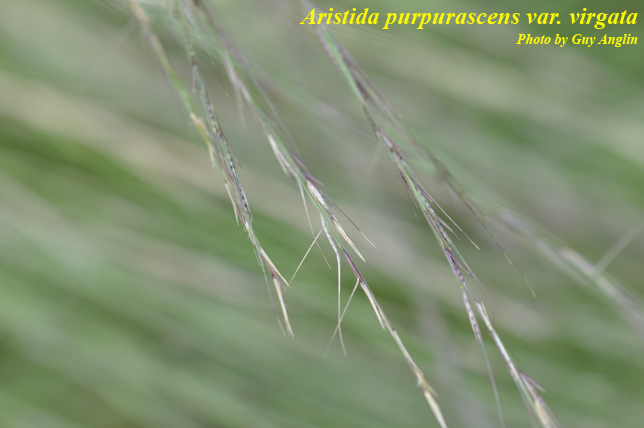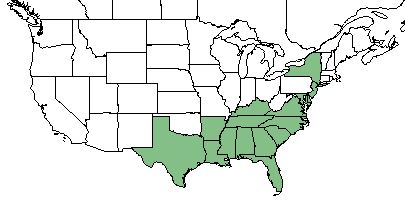Aristida virgata
Common name: Arrowfeather Threeawn [1]
| Aristida virgata | |
|---|---|

| |
| Photo by the Atlas of Florida Plants Database | |
| Scientific classification | |
| Kingdom: | Plantae |
| Division: | Magnoliophyta - Flowering plants |
| Class: | Liliopsida - Moncots |
| Order: | Cyperales |
| Family: | Poaceae |
| Genus: | Aristida |
| Species: | A. virgata |
| Binomial name | |
| Aristida virgata Trinius | |

| |
| Natural range of Aristida virgata from USDA NRCS Plants Database. | |
Contents
Taxonomic Notes
Synonyms: none.[2]
Varieties: none.[2]
Description
A. virgata is a perennial graminoid of the Poaceae family native to North America. [1] It is a tufted perennial reaching up to 1 m tall, with glabrous sheaths that can be longer or shorter than the internodes. Leaf blades flat to curling, panicles narrow with loosely to densely arranged flowers. Central awn is reflexed and twice as thick at the lateral awns.[3]
Distribution
A. virgata can be found in the southeastern United States from Texas to New York. [1]
Ecology
Habitat
A. virgata proliferates in moist to wet pine savannas, wet pine flatwoods, mountain bogs, and other moist habitats. [4] Specimens have been collected from open pine savanna near a marsh edge. [5] In Florida, A. virgata has been found to be frequent in the communities it is found.[6]
Phenology
A. virgata does not hold up well against transplanting. [7]
Fire ecology
A. virgata flourishes when the following burning treatments are applied: periodic summer and annual winter. [8]
Herbivory and toxicology
A. virgata has poor forage value,[9] but can be grazed by cattle for a short time after a burn in the spring or winter. Heavy grazing will cause this species to decrease.[10]
Conservation, cultivation, and restoration
A. virgata is listed as: a "special concern" species by the Connecticut Department of Environmental Protection, endangered by the Maryland Natural Heritage Program, and threatened by the Massachusetts Natural Heritage and Endangered Species Program, the Pennsylvania Department of Conservation and Natural Resources, and the Rhode Island Department of Environmental Management. [1]
Cultural use
Photo Gallery
References and notes
- ↑ 1.0 1.1 1.2 1.3 USDA Plant Database https://plants.usda.gov/core/profile?symbol=ARPUV
- ↑ 2.0 2.1 Weakley, A.S. 2015. Flora of the southern and mid-atlantic states. Working Draft of 21 May 2015. University of North Carolina at Chapel Hill, Chapel Hill, North Carolina.
- ↑ Allred, K. W. (1986). "Studies in the Aristida (Gramineae) of the southeastern United States. IV. Key and conspectus." Rhodora 88(855): 367-387.
- ↑ Weakley, A. S. (2015). Flora of the Southern and Mid-Atlantic States. Chapel Hill, NC, University of North Carolina Herbarium.
- ↑ URL: http://herbarium.bio.fsu.edu. Last accessed: June 2018. Collectors: Jennifer M. Fill States and counties: South Carolina (Colleton)
- ↑ Carr, S. C., et al. (2010). "A Vegetation Classification of Fire-Dependent Pinelands of Florida." Castanea 75(2): 153-189.
- ↑ Aschenbach, T. A., et al. (2010). "The initial phase of a longleaf pine-wiregrass savanna restoration: species establishment and community responses." Restoration Ecology 18(5): 762-771.
- ↑ Lewis, C. E. and T. J. Harshbarger (1976). "Shrub and herbaceous vegetation after 20 years of prescribed burning in the South Carolina coastal plain." Journal of Range Management 29(1): 13-18.
- ↑ Hilmon, J. B. (1964). "Plants of the Caloosa Experimental Range " U.S. Forest Service Research Paper SE-12
- ↑ Byrd, Nathan A. (1980). "Forestland Grazing: A Guide For Service Foresters In The South." U.S. Department of Agriculture.